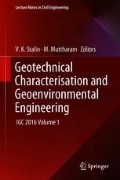Abstract
Permeability of gases through geomaterials are critical in areas like landfill cover design, buffer material characterization in deep geological repositories for radioactive waste containment, geosequestration of greenhouse gases, oil and gas recovery. In general, there are two types of laboratory methods for determination of gas permeability of geomaterials, such as steady-state and transient or pressure decay methods. In all these methods, the sample thickness that needs to be considered is important for accurate estimation of gas permeability characteristics. In view of this, the present study discusses the effect of sample thickness on the laboratory determination of gas permeation through geomaterials. A permeability apparatus has been developed for evaluating the gas permeability characteristics of geomaterials over a range of compaction state, based on the concept of pressure decay. Further, the experiments are conducted at different sample thicknesses along the standard Proctor compaction curve and the effect of sample thickness on gas permeability has been evaluated.
Access this chapter
Tax calculation will be finalised at checkout
Purchases are for personal use only
References
Ada, M. (2007) Performance assessment of compacted bentonite sand mixtures utilized as isolation material in underground waste disposal repositories. Master of science thesis, The graduate school of natural and applied sciences, Middle East Technical University, Turkey.
ASTM: D422. (2007). Standard test method for particle size analysis of soils. Annual Book of ASTM Standards 04.08, ASTM International, West Conshohocken, PA, USA.
ASTM D5550. (2006). Standard test method for specific gravity of soil solids by gas pycnometer. Annual Book of ASTM Standards 04.08, ASTM International, West Conshohocken, PA, USA.
ASTM D698. (2012). Laboratory compaction characteristics of soil using standard effort. Annual Book of ASTM Standards 04.08, ASTM International, West Conshohocken, PA, USA.
Billiotte, J., Yang, D., & Su, K. (2008). Experimental study on gas permeability of mudstones. Physics and Chemistry of the Earth, 33, S231–S236.
Bouazza, A., & Vangpaisal, T. (2003). An apparatus to measure gas permeability of geosynthetic clay liners. Geotextiles and Geomembranes, 21, 85–101.
Brace, W. F., & Martin, R. J. (1968). A test of the law of effective stress for crystalline rocks of low porosity. International Journal of Rock Mechanics and Mining Sciences, 5, 415–426.
Calogovic, V. (1995) Gas permeability measurement of porous materials (concrete) by time-variable pressure difference method. Cement and Concrete research, 25(5), 1054–1062.
Dixon, D. A., Gray, M. N., & Thomas, A. W. (1985). A study of the compaction properties of potential clay-sand buffer mixtures for use in nuclear fuel waste disposal. Engineering Geology, 21, 247–255.
Fedor, F., Hamos, G., Jobbik, A., Mathe, Z., Somodi, G., & Szucs, I. (2008). Laboratory pressure pulse decay permeability measurements of Boda Claystone. Physics and Chemistry of the Earth, 33, S45–S53.
Gardner, D. R., Jefferson, A. D., & Lark, R. J. (2008). An experimental, numerical and analytical investigation of gas flow characteristics in concrete. Cement and Concrete Research, 33, 360–367.
Moore, T. R., & Roulet, N. T. (1991). A comparison of dynamic and static chambers for methane emission measurements from subarctic fens. Atmosphere-Ocean, 29, 102–109.
Author information
Authors and Affiliations
Corresponding author
Editor information
Editors and Affiliations
Rights and permissions
Copyright information
© 2019 Springer Nature Singapore Pte Ltd.
About this paper
Cite this paper
Surya, S.S., Arnepalli, D.N. (2019). Effect of Sample Thickness on Laboratory Determination of Gas Permeability of Buffer Material. In: Stalin, V., Muttharam, M. (eds) Geotechnical Characterisation and Geoenvironmental Engineering. Lecture Notes in Civil Engineering , vol 16. Springer, Singapore. https://doi.org/10.1007/978-981-13-0899-4_18
Download citation
DOI: https://doi.org/10.1007/978-981-13-0899-4_18
Published:
Publisher Name: Springer, Singapore
Print ISBN: 978-981-13-0898-7
Online ISBN: 978-981-13-0899-4
eBook Packages: EngineeringEngineering (R0)

